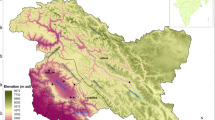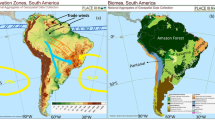Abstract
Climate change is arguably one of the most important challenges affecting different aspects of human life and the environment. The current research is an effort to assess the possible impact of climate change on precipitation, temperature, and consequently climate zones over Iran, based on the Köppen–Geiger climate classification scheme. To this end, monthly mean values of precipitation totals and air temperature from 149 synoptic stations during 1971–2015 as well as output from 17 Earth System Models of the CMIP5 (Coupled Model Intercomparison Project Phase 5) under two emission scenarios, RCP4.5 and RCP8.5, over the twenty-first century were taken into consideration. The results obtained by the ensemble mean of the 17 CMIP5 models under RCP8.5 scenario indicated that the annual mean temperature is expected to increase significantly by 1.9 and 3.3 °C for the periods of 2041–2070 and 2071–2100, respectively. For precipitation, results showed that the annual mean precipitation over the country is expected to decrease under both RCP scenarios relative to the baseline period (1971–2015) between − 5.4% by 2041–2070 under RCP4.5 and − 9.5% by 2071–2100 under RCP8.5. Monthly precipitation regimes are expected to change across the country, especially in the Caspian Sea coastal regions and in Alborz mountain ranges. The Köppen–Geiger climate classification map of Iran is derived for the period 1971–2015 and compared to existing global Köppen–Geiger climate classification maps. Also, computing climate types of Köppen–Geiger climate classification based on averages from three climatic periods (1971–2015, 2041–2070, and 2071–2100) showed that the area of arid-desert and arid-steppe climate classes (BW and BS) and the area of moderate and snow climate classes (Ds and Cs) are expected to increase and decrease, respectively. The results of this study could impact on strategic planning in agriculture and water resources, and thus consequently affecting the economy of Iran.









Similar content being viewed by others
References
Adle AH (1960) Climatic regions and vegetation in Iran. University of Tehran Press, Tehran, p 144
Barker T, Davidson O, Davidson W, Huq S, Karoly D, Kattsov V, Liu J, Lohmann U, Manning M, Matsuno T, Menne B (2007) Climate change 2007: synthesis report. IPPC, Valencia
Beck C, Grieser J, Kottek M, Rubel F, Rudolf B (2005) Characterizing global climate change by means of Köppen climate classification. Klimastatusbericht 51:139–149
Beck HE, van Dijk AI, de Roo A, Miralles DG, McVicar TR, Schellekens J, Bruijnzeel LA (2016) Global-scale regionalization of hydrologic model parameters. Water Resour Res 52(5):3599–3622
Beck HE, Zimmermann NE, McVicar TR, Vergopolan N, Berg A, Wood EF (2018) Present and future Köppen-Geiger climate classification maps at 1-km resolution. Sci Data 5:180214
Belda M, Holtanová E, Halenka T, Kalvová J (2014) Climate classification revisited: from Köppen to Trewartha. Clim Res 59(1):1–13
Belda M, Holtanová E, Kalvová J, Halenka T (2016) Global warming-induced changes in climate zones based on CMIP5 projections. Clim Res 71:17–31
Chan D, Wu Q, Jiang G, Dai X (2016) Projected shifts in Köppen climate zones over China and their temporal evolution in CMIP5 multi-model simulations. Adv Atmos Sci 33(3):283–293
Chen D, Chen HW (2013) Using the Köppen classification to quantify climate variation and change: an example for 1901–2010. Environ Dev 6:69–79
Feng S, Ho CH, Hu Q, Oglesby RJ, Jeong SJ, Kim BM (2012) Evaluating observed and projected future climate changes for the Arctic using the Köppen-Trewartha climate classification. Clim Dyn 38(7–8):1359–1373
Feng S, Hu Q, Huang W, Ho CH, Li R, Tang Z (2014) Projected climate regime shift under future global warming from multi-model, multi-scenario CMIP5 simulations. Glob Planet Chang 112:41–52
Fraedrich K, Gerstengarbe FW, Werner PC (2001) Climate shifts during the last century. Clim Chang 50(4):405–417
Gallardo C, Gil V, Hagel E, Tejeda C, de Castro M (2013) Assessment of climate change in Europe from an ensemble of regional climate models by the use of Köppen–Trewartha classification. Int J Climatol 33(9):2157–2166
Ganji MH (1955) The climate of Iran. Bull de Soc Geogr 28:195–199
Geiger R (1961) Überarbeitete Neuausgabe von Geiger, R.: Köppen-Geiger/Klima der Erde. (Wandkarte 1:16 Mill.) (Revised reissue of Geiger, R.: Köppen-Geiger/Climate of the Earth. (Wall map 1:16 Mill.)) – Klett-Perthes, Gotha
Gleckler PJ, Taylor KE, Doutriaux C (2008) Performance metrics for climate models. J Geophys Res Atmos 113(D6):1–20
Hanf F, Körper J, Spangehl T, Cubasch U (2012) Shifts of climate zones in multi-model climate change experiments using the Köppen climate classification. Meteorol Z 21(2):111–123
Hosseini-Moghari SM, Araghinejad S, Ebrahimi K (2018) Spatio-temporal evaluation of global gridded precipitation datasets across Iran. Hydrol Sci J 63(11):1669–1688
IPCC (2013) Climate change 2013: the physical science basis. Contribution of working group I to the fifth assessment report of the intergovernmental panel on climate change. Cambridge University Press, Cambridge and New York
Jawadi C (1966) Distribution climatiques en Iran. Monographie Meteorol Nat, Paris
Jylhä K, Tuomenvirta H, Ruosteenoja K, Niemi-Hugaerts H, Keisu K, Karhu JA (2010) Observed and projected future shifts of climatic zones in Europe and their use to visualize climate change information. Weather Clim Soc 2(2):148–167
Kalvová J, Halenka T, Bezpalcová K, Nemešová I (2003) Köppen climate types in observed and simulated climates. Stud Geophys Geod 47(1):185–202
Kaviani MR, Masoudian SA (2008) Climatology of Iran. Esfahan University press, Esfahan
Khalili A, Rahimi J (2018) Climate. In: Roozitalab M, Siadat H, Farshad A (eds) The soils of Iran. World Soils Book Series. Springer, Cham
Khalili A, Darvish Sefat A, Baradaran-e-rade R, Bazrafshan J (2004) Method for climatic classification on selianinov system in GIS media (a case study for north west of Iran). Biaban (Desert) 9(2):227–237 [In Persian]
Knutti R, Allen MR, Friedlingstein P, Gregory JM, Hegerl GC, Meehl GA, Meinshausen M, Murphy JM, Plattner GK, Raper SCB, Stocker TF (2008) A review of uncertainties in global temperature projections over the twenty-first century. J Clim 21(11):2651–2663
Köppen W (1936) Das geographische System der Klimate. In: Köppen W, Geiger R (eds) Handbuck der Klimatologie Bd. 1, Teil C. Gebrüder Bornträger, Berlin
Kottek M, Grieser J, Beck C, Rudolf B, Rubel F (2006) World map of the Köppen-Geiger climate classification updated. Meteorol Z 15(3):259–263
Mahlstein I, Daniel JS, Solomon S (2013) Pace of shifts in climate regions increases with global temperature. Nat Clim Chang 3(8):739–743
Mirmousavi SM, Kiani H (2017) An investigation on Köppen’s climate classification in 1975 in comparison with the output of MIROC in the years 2030, 2050, 2080, and 2100 under scenario A1B and A2. Geogr Environ Hazards 6(22):59–72 [in Persian]
Peel MC, Finlayson BL, McMahon TA (2007) Updated world map of the Köppen-Geiger climate classification. Hydrol Earth Syst Sci 11:1633–1644
Phillips TJ, Gleckler PJ (2006) Evaluation of continental precipitation in 20th century climate simulations: the utility of multimodel statistics. Water Resour Res 42(3):1–10
Pierce DW, Barnett TP, Santer BD, Gleckler PJ (2009) Selecting global climate models for regional climate change studies. Proc Natl Acad Sci pnas-0900094106
Rahimi J, Khalili A (2019) Potential impacts of climate change on precipitation patterns over Iran (an arid/semi-arid climate). Int J Hydrol Sci Technol 9(5):569–585
Rahimi J, Ebrahimpour M, Khalili A (2013) Spatial changes of extended De Martonne climatic zones affected by climate change in Iran. Theor Appl Climatol 112(3–4):409–418
Rahimi J, Khalili A, Bazrafshan J (2017) Evaluation of different missing data reconstruction methods for daily minimum temperature in elevated stations of Iran: comparison with new proposed approach. Iran J Soil Water Res 48(2):231–238 [In Persian]
Rahimi J, Malekian A, Khalili A (2018) Climate change impacts in Iran: assessing our current knowledge. Theor Appl Climatol 135(1–2):545–564
Rahimi J, Khalili A, Butterbach-Bahl K (2019) Projected changes in modified Thornthwaite climate zones over Southwest Asia using a CMIP5 multi-model ensemble. Int J Climatol. https://doi.org/10.1002/joc.6088
Ramírez Villegas J, Jarvis A (2010) Downscaling global circulation model outputs: the delta method decision and policy analysis working paper no. 1
Raziei T (2017a) An outlook on the Iranian Köppen-Geiger climate zones in the 21st century. Iran J of Geophys 11(1):84–100 [in Persian]
Raziei T (2017b) Köppen-Geiger climate classification of Iran and investigation of its changes during 20th century. J Earth Space Phys 43(2):419–439 [in Persian]
Reichler T, Kim J (2008) How well do coupled models simulate today’s climate? Bull Am Meteorol Soc 89(3):303–312
Rohli RV, Andrew Joyner T, Reynolds SJ, Shaw C, Vázquez JR (2015) Globally extended Kӧppen–Geiger climate classification and temporal shifts in terrestrial climatic types. Phys Geogr 36(2):142–157
Rubel F, Kottek M (2010) Observed and projected climate shifts 1901–2100 depicted by world maps of the Köppen-Geiger climate classification. Meteorol Z 19(2):135–141
Rubel F, Brugger K, Haslinger K, Auer I (2016) The climate of the European Alps: shift of very high resolution Köppen-Geiger climate zones 1800–2100. Meteorol Z 26(2):115–125
Shin SH, Bae DH (2013) Future projections of Köppen climate shifts in the Asia regions using A2 scenario. J Korea Water Resour Assoc 46(3):253–265
Suckling PW, Mitchell MD (2000) Variation of the Köppen C/D climate boundary in the Central United States during the 20th century. Phys Geogr 21(1):38–45
Taylor KE (2001) Summarizing multiple aspects of model performance in a single diagram. J Geophys Res Atmos 106(D7):7183–7192
Taylor KE, Stouffer RJ, Meehl GA (2012) An overview of CMIP5 and the experiment design. Bull Am Meteorol Soc 93(4):485–498
Tebaldi C, Knutti R (2007) The use of the multi-model ensemble in probabilistic climate projections. Philos Trans A Math Phys Eng Sci 365(1857):2053–2075
Trewartha GT (1968) An introduction to climate. McGraw-Hill, New York
Van Vuuren DP, Edmonds J, Kainuma M, Riahi K, Thomson A, Hibbard K, Hurtt GC, Kram T, Krey V, Lamarque JF, Masui T, Meinshausen M, Nakicenovic N, Smith SJ, Rose SK (2011) The representative concentration pathways: an overview. Clim Chang 109:5–31
Verner D (Ed.) (2012) Adaptation to a changing climate in the Arab countries: a case for adaptation governance and leadership in building climate resilience. The World Bank
Wang M, Overland JE (2004) Detecting Arctic climate change using Köppen climate classification. Clim Chang 67(1):43–62
World Meteorological Organization (2017). WMO guidelines on the calculation of climate normals
Yoo J, Rohli RV (2016) Global distribution of Köppen–Geiger climate types during the last glacial maximum, mid-Holocene, and present. Palaeogeogr Palaeoclimatol Palaeoecol 446:326–337
Acknowledgments
This work has been supported by Iran National Science Foundation (INSF) and executed at University of Tehran-College of Agricultural and Natural Resources (UTCAN).
Author information
Authors and Affiliations
Corresponding author
Additional information
Publisher’s note
Springer Nature remains neutral with regard to jurisdictional claims in published maps and institutional affiliations.
Rights and permissions
About this article
Cite this article
Rahimi, J., Laux, P. & Khalili, A. Assessment of climate change over Iran: CMIP5 results and their presentation in terms of Köppen–Geiger climate zones. Theor Appl Climatol 141, 183–199 (2020). https://doi.org/10.1007/s00704-020-03190-8
Received:
Accepted:
Published:
Issue Date:
DOI: https://doi.org/10.1007/s00704-020-03190-8




